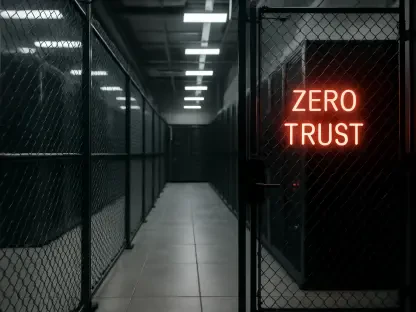In a landmark announcement for the tech industry, Microsoft and Atom Computing unveiled a revolutionary commercial quantum machine equipped with 24 entangled logical qubits. The breakthrough represents a significant leap in addressing long-standing challenges related to error detection and correction in quantum computing. The collaboration between these industry leaders promises to pave the way for quantum advancements across various scientific and industrial domains.
Breakthrough in Quantum Computing
Combining Technologies for a Quantum Leap
This quantum machine results from the synergistic combination of Atom Computing’s advanced neutral-atom hardware with Microsoft’s cutting-edge qubit-virtualization technology. The development, made public at the highly anticipated Microsoft Ignite 2024 event, is integrated within the comprehensive Azure Quantum platform and seamlessly ties in with the Azure Elements suite. The primary objective behind this collaboration is to establish a highly stable and dependable environment for quantum applications, potentially transforming fields such as artificial intelligence (AI), chemistry, and materials science.
By integrating these cutting-edge technologies, the new quantum machine promises to overcome significant hurdles that have previously hindered quantum computing. Atom Computing’s neutral-atom hardware offers substantial benefits, including enhanced scalability and reduced noise sensitivity, which are essential for effective error correction. Microsoft’s qubit-virtualization technology complements these hardware capabilities by creating logical qubits, thereby increasing the overall stability of quantum operations. This combined approach holds the potential to revolutionize the practical implementation of quantum applications across various scientific disciplines.
Enhancing Stability and Reliability
One of the key takeaways from this joint venture is the marked improvement in the stability and reliability of quantum operations using the new machine. Logical qubits, which are inherently more stable and less prone to errors than physical qubits, play a crucial role in achieving practical quantum advantages in real-world applications. While physical qubits serve as the fundamental building blocks of quantum computing, they are highly susceptible to errors induced by several factors, including environmental noise, hardware imperfections, and quantum decoherence.
Logical qubits mitigate these challenges by utilizing multiple physical qubits and implementing sophisticated quantum error-correction techniques. By combining these elements, logical qubits significantly enhance computational reliability, making them indispensable for developing practical quantum computing solutions. The improved stability and reliability of quantum operations offered by logical qubits open up new possibilities for advancements in a wide array of fields, ultimately bringing the promise of quantum computing closer to reality.
Technological Innovations
Neutral-Atom Qubits and Qubit-Virtualization
Ben Bloom, CEO of Atom Computing, highlighted the groundbreaking nature of the new system integrating state-of-the-art neutral-atom qubits with Microsoft’s innovative qubit-virtualization technology. This advancement is expected to catalyze rapid progress in fields such as chemistry and materials science by providing reliable logical qubits for commercial use. Neutral-atom qubits form the core of Atom Computing’s approach, employing laser pulses to manipulate atoms for storing and processing quantum information. This design’s inherent advantages, including scalability and reduced noise sensitivity, are vital for effective error correction.
Microsoft’s qubit-virtualization system augments these physical qubits, transforming them into more stable logical qubits suitable for robust quantum operations. This powerful combination of hardware and software technologies enables the development of highly reliable quantum systems, setting a new standard in error correction and stability. The innovative approach allows researchers and industry professionals to leverage the full potential of quantum computing, driving progress in various scientific and technological fields.
Achieving High Fidelity and Error Correction
The reliability of the new quantum machine is underscored by its impressive two-qubit gate fidelity of 99.6% and its capacity to detect and correct errors even in the face of qubit losses. The achievement of entangling 24 logical qubits in a Greenberger-Horne-Zeilinger (GHZ) state is touted as a record-breaking milestone, setting a significant benchmark in the field of quantum computing. This high level of fidelity and error correction capability is essential for the practical implementation of quantum applications, ensuring that computations remain accurate and reliable.
The entangled logical qubits’ extraordinary stability and reliability are critical for addressing complex problems that classical computers cannot solve. This advancement represents a significant step toward achieving scientific quantum advantage, where quantum systems can tackle challenges that are currently unsolvable by traditional computational methods. The high benchmarks established by this collaborative effort between Microsoft and Atom Computing signify a pivotal moment in the quest for practical, fault-tolerant quantum computing, heralding a new era of technological innovation.
Previous Collaborations and Progress
Microsoft and Quantinuum’s Achievements
The recent breakthrough announced by Microsoft and Atom Computing builds upon previous collaborations in the quantum computing space. In September 2024, Microsoft partnered with Quantinuum to leverage Azure Quantum’s qubit-virtualization system alongside Quantinuum’s ## trapped-ion quantum computer. This collaboration successfully created 12 highly reliable logical qubits, demonstrating the potential of hybrid quantum-classical computing. By integrating logical qubits with AI models and high-performance cloud computing (HPC), they estimated the ground state energy of a catalytic intermediate, showcasing the practical applications of advanced quantum systems.
This earlier work also highlighted significant advancements in error correction, achieving error rates that were 800 times better than those of the underlying physical qubits. These achievements underscore the importance of ongoing innovation and collaboration in the field, as continuous progress in error detection and correction is crucial for realizing the full potential of quantum computing. The experience gained from these projects has laid a strong foundation for the current advancements, positioning Microsoft and its partners at the forefront of the quantum computing revolution.
Focus on Scientific Quantum Advantage
The consistent progress made by Microsoft is part of its broader focus on achieving scientific quantum advantage—solving complex problems with quantum systems that classical computers are incapable of addressing. Azure Quantum’s platform plays a pivotal role in this pursuit, combining state-of-the-art hardware and software to prioritize dependable quantum computation. This integrated approach seeks to provide a stable and repeatable quantum computing environment that can be utilized in various scientific and industrial applications.
The Azure platform’s additional capabilities, such as AI-driven tools and high-performance computing, enhance the potential for practical quantum computing solutions. By focusing on reliability and leveraging the power of logical qubits, Microsoft aims to drive advancements in diverse fields, from materials science to medical research. This strategic emphasis on scientific quantum advantage reflects Microsoft’s commitment to pushing the boundaries of technology and making tangible progress in areas where traditional computing methods fall short.
Industry Comparisons
Microsoft vs. IBM: Different Approaches
While Microsoft and Atom Computing emphasize reliability with their system of 24 entangled logical qubits, their approach contrasts with IBM’s focus on scale and computational speed. IBM’s recent unveiling of its most advanced quantum processor, Quantum Heron, exemplifies this divergence. The Quantum Heron processor is capable of executing up to 5,000 two-qubit gate operations, nearly doubling the benchmark set in the previous year. IBM’s significant advancements in computation time for complex quantum experiments, achieving a 50-fold reduction compared to 2023 benchmarks, highlight their focus on rapid scalability and computational power.
These differing priorities—Microsoft’s emphasis on error correction and IBM’s focus on enhancing computational speed—illustrate distinct paths toward realizing quantum advantage. IBM’s approach pushes the boundaries of quantum utility in fields like materials science and life sciences, while Microsoft’s strategy aims to ensure reliable quantum operations. This contrast highlights the importance of both reliability and speed as critical components in the pursuit of practical quantum computing solutions. Different strategies employed by industry leaders demonstrate the multifaceted nature of quantum computing advancements required to achieve widespread adoption.
Reliability vs. Speed in Quantum Computing
The back-and-forth dynamics between reliability and speed in quantum computing are evident in the distinct approaches taken by industry giants like Microsoft and IBM. While Microsoft prioritizes the stability and dependability of logical qubits to achieve practical quantum computations, IBM’s focus on scaling and enhancing computational speed highlights its commitment to making quantum computing more efficient and accessible. These contrasting strategies underscore the diverse challenges that must be addressed to achieve widespread adoption and practical implementation of quantum systems in real-world applications.
IBM’s advancements in computation time and scalability showcase significant progress in pushing the limits of what quantum computing can achieve, particularly in fields that require extensive computational power. Microsoft’s emphasis on error correction and the stability of quantum operations ensures that the quantum systems developed are highly reliable and capable of addressing complex problems with greater accuracy. Both approaches play crucial roles in advancing the field of quantum computing, and their combined contributions are essential for realizing the transformative potential of this revolutionary technology.
The Future of Quantum Computing
Overcoming Challenges with Logical Qubits
The superiority of logical qubits, highlighted by Microsoft and Atom Computing’s latest endeavor, further distinguishes them in an industry where traditional error-prone systems continue to pose significant challenges. Competitors such as IBM and Google have developed alternative quantum technologies, like superconducting qubits, but often grapple with higher noise levels that impede scalability and stability. Neutral-atom qubits, as championed by Atom Computing, offer inherent benefits, including scalability through compact arrays and lower noise susceptibility, making them particularly suitable for error correction.
Achieving widespread adoption of quantum systems necessitates continuous improvements in both hardware and software. Technological advancements by industry giants like IBM, Google, and Microsoft exemplify various approaches to error detection and correction, each contributing uniquely to the field. IBM, for instance, employs highly efficient quantum error-correcting codes and co-designs these codes with their hardware. Google focuses on surface codes, real-time decoders, leakage mitigation, and stabilizer codes for exponential error suppression. Each of these approaches is critical in overcoming the inherent challenges of quantum computing and moving the industry closer to practical, fault-tolerant systems.
The ability to offer reliable systems could become a key differentiator as the race to develop practical quantum computing intensifies. The commercial success of these systems will hinge not only on their technical performance but also on their capacity to meet real-world needs across diverse industries. Each major player in the tech industry is making significant contributions toward practical, fault-tolerant quantum computing, and their unique approaches to tackling the challenges of error detection and correction are paving the way for broader advancements in the field.
Conclusion
In a groundbreaking announcement for the tech industry, Microsoft and Atom Computing have introduced a cutting-edge commercial quantum machine with 24 entangled logical qubits. This breakthrough marks a major step forward in tackling the persistent challenges associated with error detection and correction in quantum computing. The collaboration between these two industry giants signifies a promising future for quantum advancements across various scientific and industrial sectors. By leveraging their combined expertise, Microsoft and Atom Computing aim to accelerate the development and application of quantum technologies, potentially revolutionizing fields such as cryptography, material science, and complex system modeling. As quantum computing continues to evolve, the partnership is expected to drive significant progress and innovation, further solidifying the role of quantum technology in solving some of the most complex problems faced by humanity today. This announcement is not only a milestone for quantum computing but also highlights the importance of collaborative efforts in pushing the boundaries of what is technologically possible.









